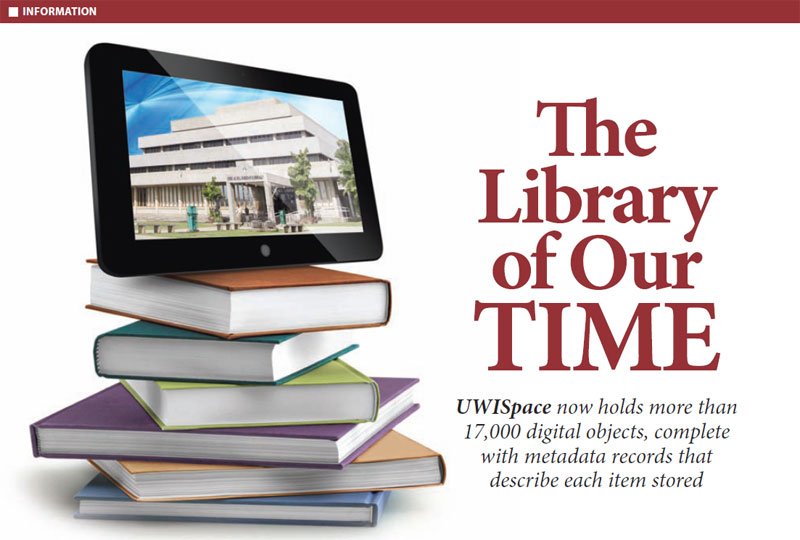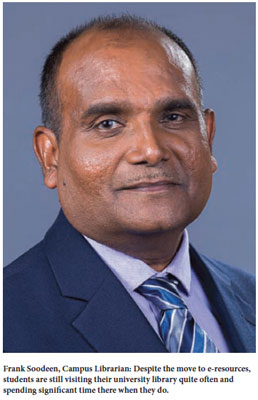
 A few months ago, UWI Press announced that 250 books from its catalogue had been digitized and would be available as an online library for subscribers. The Alma Jordan Library (AJL) at the St. Augustine Campus was responsible for developing the technical platform on which this e-book library will be hosted. In many ways this collaborative project is in keeping with the Library’s drive to help shape and support the scholarly communication and publishing landscape across the University and the Caribbean. A few months ago, UWI Press announced that 250 books from its catalogue had been digitized and would be available as an online library for subscribers. The Alma Jordan Library (AJL) at the St. Augustine Campus was responsible for developing the technical platform on which this e-book library will be hosted. In many ways this collaborative project is in keeping with the Library’s drive to help shape and support the scholarly communication and publishing landscape across the University and the Caribbean.
“Features of the new site developed by the AJL include responsive design, tailoring the attractive and functional interface to any device; turning pages; and such tools as advanced search filters, social sharing, and reading recommendations using linked data and elements of the semantic web,” says the new Campus Librarian, Frank Soodeen, with some pride.
In a sense it was the kind of project they had been anticipating for 16 years at the AJL, ever since Soodeen moved the in-house available only library catalogue to the world-wide web and began digitizing content for student use and access. The first digitization project involved scanning UWI past exam papers and making them available via the Library’s web site as a solution to the ever increasing demand for the limited number of print copies that were housed in the Reserves Collection. “The database that was developed now holds just over 13,000 past papers covering the years 1993 to 2016,” he says.
The digitization programme at the AJL evolved over the years and a repository had to be established to house the digital objects created. The UWISpace institutional repository was therefore set up in 2009 to capture and preserve digitized content not only from the AJL collections, but also the intellectual record of the St. Augustine Campus. In the UWISpace archive there is the precious West Indiana material, which includes special collections, UWI post graduate e-theses, the recently acquired audio news reports from the BBC Caribbean Service, the Goldberg Collection of postcards; faculty material, pre-prints and post publication versions of scholarly articles produced by the University community. The repository was eventually extended to allow submission of digitized content from all the UWI campuses as it was known that university research in most instances being born digital, there was no framework for managing the archiving and proper preservation of this content.
UWISpace now holds more than 17,000 digital objects, complete with metadata records that describe each item stored. Content management portals such as UWISpace have really opened the door for libraries to be agile, efficient and ubiquitous; for UWI it has meant support for administrative, teaching and research programmes.
“We want to push this model,” says Soodeen. “The Library now has two faces – one of brick and mortar and the online presence.”
It has been about six months since Soodeen took up the position of Campus Librarian after the retirement of Jennifer Joseph. His priorities for the next five years include “engagement and outreach, harnessing and distributing Caribbean content, organizational learning and growth, prudent fiscal management and developing a culture of accountability and assessment,” he says.
He’s already done some physical work in what he describes as “re-engineering spaces” to add facilities like a research commons – spaces for undergraduate students, collaborative learning rooms, media centres and general improvements to enhance the brick and mortar element, but he has a clear idea of the role of a university library in today’s world of technology.
“Despite the move to e-resources, students are still visiting their university library quite often and spending significant time there when they do. Particularly in the arts and humanities, undergraduates may well spend more time with their librarian than with their lecturer. That time is spent supporting students to become self-directed learners through our information literacy consultations,” he says.
“We are the stewards of the heritage materials of the region, organizing them for access, and preservation, and to represent the cultural identity of the Caribbean. The technology helps us to make that heritage visible to the world. Once digitized, content from institutions such as The UWI can be an important economic force as a source of material to be re-used for added-value services and products in sectors such as tourism and education, for example.”
The challenges are many and the resources are few, but Soodeen is committed to finding creative and innovative ways to keep on the edge of technology, and he believes it will come by continuous collaboration with faculty, researchers and students, aligning library services in terms of the evolving teaching and learning modalities.
He wants people to see the library as both a physical and virtual environment, and as a place of learning – a cultural and social space.
(Vaneisa Baksh)
|





